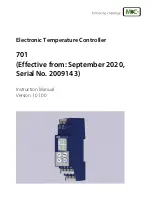
Message
Explanation
Action
Configured drives
are not in the
configured
location.
When the ServeRAID controller
detects that a previously configured
drive is present, but the drive is in
a new location, the following
message appears:
x Online drive has been rearranged
where x is the number of drives
that have been rearranged.
For example:
Examples of possible messages
are:
Online Drive on Channel 3 SCSI
ID 4 moved to Channel 3 SCSI
ID 3
Online Drive on Channel 3 SCSI
ID 3 moved to Channel 3 SCSI
ID 4
Press one of the following keys:
F2
Detailed description. Press this key for a detailed
description of the problem, such as the example
messages above.
F4
Retry. Press this key after correcting a problem. For
example, press F4 after you move the physical drive
to its previously assigned location.
F5
Change the configuration and set the drive to
defunct. Press this key to accept the new state that
the ServeRAID controller will assign to the drive.
For example, the ServeRAID controller will assign
the drive a state of defunct or empty.
Note: A physical drive in the defunct state does not
necessarily mean that you need to replace the
drive. Before you replace the drive, ensure that:
1. All cables are connected properly to the
backplane and to the physical drive. Also,
ensure that all cables inside the server are
connected properly.
2. The hot-swap drive trays are seated properly in
the drive bay.
3. If multiple drives fail in separate arrays (one
physical drive per array), then replace each of
the defunct physical drives. If multiple physical
drives fail at the same time within the same
array, contact your IBM service representative.
See “Rebuilding a defunct drive” on page 68 for
more information.
After you perform these steps, if the physical drive
does not function properly, replace the drive.
F6
Change the configuration and accept the
rearrangement. Press this key to change the
configuration to match the current drive location.
You might remove the hot-swap drives from the
server for security or maintenance reasons. If you
replace the drives but install them in different drive
bays, you can press F6 to accept the new locations,
and the ServeRAID controller will update the
configuration.
F10
Continue startup without changing the configuration.
Press this key to continue without change to the
configuration.
Controller is not
responding to
commands. No
logical drives are
installed.
The ServeRAID controller is not
operational.
Have the server serviced.
Chapter 9. Solving ServeRAID problems
59
Summary of Contents for Netfinity ServeRAID-4L Ultra160
Page 1: ...IBM Netfinity ServeRAID 4L Ultra160 SCSI Controller User s Reference SC06 P461 10...
Page 2: ......
Page 3: ...IBM Netfinity ServeRAID 4L Ultra160 SCSI Controller User s Reference SC06 P461 10...
Page 12: ...x IBM Netfinity ServeRAID 4L Ultra160 SCSI Controller User s Reference...
Page 15: ...Part 1 Installation and configuration Copyright IBM Corp 2000 1...
Page 16: ...2 IBM Netfinity ServeRAID 4L Ultra160 SCSI Controller User s Reference...
Page 34: ...20 IBM Netfinity ServeRAID 4L Ultra160 SCSI Controller User s Reference...
Page 50: ...36 IBM Netfinity ServeRAID 4L Ultra160 SCSI Controller User s Reference...
Page 51: ...Part 2 Utility programs Copyright IBM Corp 2000 37...
Page 52: ...38 IBM Netfinity ServeRAID 4L Ultra160 SCSI Controller User s Reference...
Page 56: ...42 IBM Netfinity ServeRAID 4L Ultra160 SCSI Controller User s Reference...
Page 64: ...50 IBM Netfinity ServeRAID 4L Ultra160 SCSI Controller User s Reference...
Page 68: ...54 IBM Netfinity ServeRAID 4L Ultra160 SCSI Controller User s Reference...
Page 69: ...Part 3 Maintenance and troubleshooting Copyright IBM Corp 2000 55...
Page 70: ...56 IBM Netfinity ServeRAID 4L Ultra160 SCSI Controller User s Reference...
Page 93: ...Part 4 Appendixes Copyright IBM Corp 2000 79...
Page 94: ...80 IBM Netfinity ServeRAID 4L Ultra160 SCSI Controller User s Reference...
Page 113: ......
















































